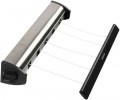Material
The main material from which the dryer is made.
— Aluminium. These models, crafted from lightweight and usually affordable aluminium alloys, come with both low weight and cost. However, compared to steel, inexpensive aluminium alloys typically lag behind in terms of strength and durability. Additionally, continuous exposure to water may cause oxidation, resulting in potential stains. While high-quality alternatives address these issues, they come with a corresponding increase in cost.
— Steel. Modern dryers typically utilize two main types of steel: regular and stainless. Ordinary steel boasts good strength at a low cost, although it is heavier than aluminium, which is not a critical factor. However, ordinary steel is prone to rust when exposed to moisture, necessitating protective coatings that can compromise the product's reliability and durability. On the other hand, stainless steel shares the same advantages but is corrosion-resistant and offers long-term use. Its main drawback is the higher price.
— Aluminium/steel. Two design types fit into this category. The first involves combined products, where the stand and main frame are typically crafted from steel, while the bars are made of aluminium. As detailed above, both materials have their characteristics, and combining them slightly boosts the strength and reliability of the dryer while keeping costs low. Additionally, models are available in various materials, including "aluminium.../steel."
— Plastic. The main advantage of plastic as a material for dryers is complete chemical inertness — in other words, it does not oxidize from constant contact with moisture. At the same time, in terms of strength, plastic significantly loses to metals. Therefore, this option is used mainly in small-sized designs that are not designed for a large amount of laundry.
